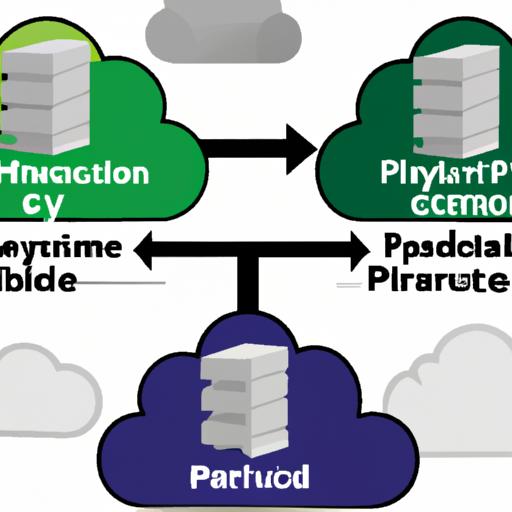Cloud computing has revolutionized the way businesses operate, streamlining processes and maximizing efficiency. As technology continues to evolve, organizations are presented with a multitude of options when it comes to cloud deployment. Among these options are public, private, and hybrid cloud solutions. In this article, we will delve into the world of cloud computing and explore the defining characteristics, advantages, and considerations of each cloud model.
Definition of Public, Private, and Hybrid Cloud
Let’s start by understanding the fundamental differences between public, private, and hybrid cloud. Public cloud refers to a cloud computing model where resources, such as storage and applications, are provided by third-party service providers over the internet. On the other hand, private cloud involves the creation of a dedicated cloud infrastructure solely for one organization, either on-premises or hosted by a third-party. Lastly, hybrid cloud combines both public and private cloud environments, allowing organizations to leverage the benefits of each model and seamlessly integrate their IT infrastructure.
Importance and Benefits of Cloud Computing
Cloud computing has become an integral part of modern business operations, offering a plethora of benefits. Firstly, it provides unparalleled scalability, allowing businesses to easily adjust their resources based on demand. This flexibility not only enhances operational efficiency but also enables cost savings by eliminating the need for expensive infrastructure investments. Additionally, cloud computing facilitates seamless collaboration and remote work, enabling teams to work together efficiently from anywhere in the world.
Cloud computing also ensures data security and disaster recovery. Public, private, and hybrid clouds employ robust security measures, including encryption and access controls, to protect sensitive information. Furthermore, cloud-based backup and recovery solutions offer peace of mind, safeguarding critical data against unforeseen events.
In conclusion, cloud computing has revolutionized the way businesses operate, providing scalability, cost-efficiency, enhanced collaboration, and robust security. In the following sections, we will delve deeper into each cloud model, uncovering their unique advantages and considerations. So, let’s embark on this journey to unravel the power of public, private, and hybrid cloud solutions.
Public Cloud
Explanation of Public Cloud
Public cloud is a cloud computing model that offers resources and services to multiple organizations or individuals over the internet. In this model, the infrastructure is owned and managed by third-party providers, relieving businesses of the burden of maintaining on-premises servers and hardware. Public cloud services are accessible to users on a pay-as-you-go basis, providing scalability and cost-effectiveness.
Characteristics and Advantages of Using Public Cloud
One of the key characteristics of the public cloud is its scalability. Public cloud providers have vast resources available, allowing businesses to easily scale up or down based on their needs. This flexibility is particularly beneficial for businesses with fluctuating workloads or seasonal demands.
Another advantage of the public cloud is its cost-effectiveness. With no upfront infrastructure investments required, businesses can reduce their capital expenses. Public cloud providers typically operate on a subscription-based model, allowing organizations to pay only for the resources they consume. This pay-as-you-go approach ensures cost optimization and eliminates the need for overprovisioning.
Examples of Popular Public Cloud Providers
Several renowned public cloud providers dominate the market, each offering a unique set of features and services. Amazon Web Services (AWS), Microsoft Azure, and Google Cloud Platform (GCP) are among the leading players in the public cloud arena. AWS, for instance, offers a wide range of services, including storage, computing power, databases, and machine learning capabilities. Microsoft Azure provides a comprehensive suite of cloud services, while GCP focuses on innovative solutions and advanced analytics.
Considerations and Potential Drawbacks of Public Cloud
While the public cloud offers numerous benefits, there are considerations and potential drawbacks that organizations should be aware of. One major concern is the issue of data security. Entrusting sensitive data to a third-party provider requires thorough evaluation of their security measures and compliance with industry regulations. Additionally, reliance on internet connectivity can pose challenges, as any disruptions may impact access to cloud services.
Furthermore, organizations must consider the potential for vendor lock-in. Switching between public cloud providers can be complex and costly, so careful planning and consideration of long-term business goals are essential.
In the next section, we will explore the private cloud model, its unique characteristics, and the advantages it brings to businesses. So, let’s dive into the world of private cloud computing.
Private Cloud: Empowering Organizations with Unmatched Control and Security
Definition and Features of Private Cloud
Private cloud, as the name suggests, offers a dedicated cloud infrastructure exclusively for one organization. It can be hosted on-premises or by a third-party service provider, providing organizations with complete control over their data and resources. The distinguishing feature of a private cloud is its isolated nature, ensuring that the infrastructure is not shared with other organizations.
Advantages and Use Cases of Private Cloud
The advantages of a private cloud are vast and significant. Firstly, organizations benefit from enhanced security and compliance. As data remains within the organization’s own infrastructure, sensitive information is shielded from potential breaches. This is particularly crucial for industries with strict regulatory requirements, such as healthcare and finance.
Additionally, a private cloud grants organizations unparalleled control and customization options. Companies can tailor the infrastructure to their specific needs, optimizing performance and resource allocation. This level of control allows for seamless integration with existing systems and applications, ensuring a smooth transition to the cloud.
Private clouds are particularly suitable for organizations that handle sensitive data or have high computing demands. Industries such as government agencies, financial institutions, and research organizations often rely on private cloud solutions to meet their unique requirements.
Comparison with Public Cloud
While public cloud solutions offer scalability and cost-effectiveness, private cloud deployments excel in terms of control, security, and customization. Unlike public cloud environments, private clouds are not subject to the shared infrastructure limitations that come with multi-tenancy. This exclusivity provides organizations with greater control over their resources, ensuring consistent performance and high availability.
Challenges and Considerations in Implementing a Private Cloud
Implementing a private cloud infrastructure is not without its challenges. One significant consideration is the upfront investment required to build and maintain the infrastructure. Organizations must carefully assess their budget and resources to ensure a successful implementation. Additionally, the expertise needed to deploy and manage a private cloud may require specialized IT skills or external assistance.
Furthermore, scalability can be a potential challenge for private clouds. Unlike public cloud environments, where resources can be easily scaled up or down, private clouds require careful planning and resource allocation to accommodate growth and changing demands.
In the next section, we will explore the concept of hybrid cloud, which combines the best of both public and private cloud models. Join me as we unravel the benefits and integration challenges of this dynamic cloud solution.
Hybrid Cloud
Understanding Hybrid Cloud Architecture
Hybrid cloud architecture combines the best of both public and private clouds, offering organizations unparalleled flexibility and control over their data and applications. It allows businesses to seamlessly integrate their on-premises infrastructure with public cloud services, creating a unified environment that meets their specific needs.
Hybrid cloud architecture typically involves a combination of private and public cloud resources interconnected through secure networks. This architecture enables organizations to take advantage of the scalability, cost-effectiveness, and vast resources available in the public cloud, while also maintaining sensitive data and critical workloads on their private infrastructure.
Benefits and Use Cases of Hybrid Cloud
The hybrid cloud model brings forth numerous benefits that cater to the diverse needs of organizations. Firstly, it allows businesses to optimize their IT infrastructure by leveraging the benefits of public cloud services for non-sensitive workloads, while keeping mission-critical data and applications in a private cloud setting. This setup ensures data security and compliance while maximizing efficiency and cost-effectiveness.
Another advantage of hybrid cloud is its ability to handle fluctuating workloads. Organizations can scale their resources up or down by seamlessly integrating public cloud resources during peak periods or high-demand situations. This flexibility eliminates the need for over-provisioning and allows businesses to save costs by paying only for the resources they use.
Hybrid cloud also facilitates disaster recovery and business continuity. By replicating critical data and applications across both private and public clouds, organizations can ensure that their operations remain uninterrupted even in the event of a local infrastructure failure.
Integration Challenges and Strategies
While hybrid cloud offers immense benefits, it does come with certain integration challenges. One of the main hurdles is ensuring seamless connectivity and data synchronization between the private and public cloud environments. Organizations need to implement robust networking solutions and establish secure connections to ensure smooth data transfer and communication.
Furthermore, managing and monitoring the hybrid cloud environment can be compleOrganizations must have the right tools and expertise to effectively manage workloads, optimize resource allocation, and maintain security across both cloud environments. Implementing proper governance and monitoring strategies is crucial to maximize the advantages of hybrid cloud.
Examples of Successful Hybrid Cloud Deployments
Numerous organizations have successfully implemented hybrid cloud strategies to enhance their operations. For instance, international retail giant Walmart utilizes hybrid cloud to process and analyze vast amounts of customer data. By leveraging public cloud resources for data analysis and insights, Walmart can make data-driven decisions while maintaining sensitive customer information on their private infrastructure.
Another notable example is Netflix, the popular streaming service. Netflix utilizes hybrid cloud architecture to scale its streaming platform during peak usage periods. By seamlessly scaling their resources in the public cloud, Netflix can deliver a seamless streaming experience to millions of users worldwide.
In conclusion, hybrid cloud architecture combines the benefits of public and private clouds, offering organizations unmatched flexibility, scalability, and security. By understanding its architecture, harnessing its benefits, addressing integration challenges, and learning from successful deployments, organizations can effectively leverage the power of hybrid cloud to drive innovation and achieve their business objectives.
Choosing the Right Cloud Model
With the multitude of cloud options available, it can be challenging to determine which model best suits your organization’s needs. Whether it’s public, private, or hybrid cloud, careful consideration of various factors is crucial to making an informed decision.
Factors to Consider
When evaluating cloud models, several factors come into play. Firstly, consider the level of security required for your data and applications. While public cloud providers invest heavily in security measures, private cloud offers greater control and customization options, making it an ideal choice for organizations dealing with sensitive information.
Scalability is another vital aspect to consider. Public cloud solutions provide virtually limitless scalability, enabling you to easily scale up or down based on demand. Private cloud, although offering scalability, may require additional investments in infrastructure to achieve the same level of flexibility.
Cost is often a deciding factor when choosing a cloud model. Public cloud is typically more cost-effective as it eliminates the need for upfront hardware investments and reduces maintenance costs. Private cloud, on the other hand, requires initial capital expenditure but may prove more cost-efficient in the long run for organizations with predictable workloads and specific compliance requirements.
Control is an essential consideration, especially for industries with stringent regulatory requirements. Private cloud offers greater control over data storage, access, and compliance, making it an attractive option for organizations in finance, healthcare, or government sectors.
Case Studies
Examining real-world examples can provide valuable insights into the benefits and challenges of different cloud models. Consider the case of Company A, a small startup looking to rapidly scale its operations. By opting for public cloud services, they gained the ability to easily expand their infrastructure without the burden of significant capital expenditure. The scalability and cost-effectiveness of the public cloud enabled Company A to focus on innovation and growth.
Alternatively, Company B, a healthcare organization, required a secure and compliant environment for their sensitive patient data. By implementing a private cloud solution, they maintained full control over their infrastructure and ensured compliance with strict regulations. The added security and customization capabilities of the private cloud allowed Company B to safeguard patient information and meet industry-specific requirements.
In conclusion, when choosing a cloud model, it is crucial to evaluate factors such as security, scalability, cost, and control. By carefully considering these aspects and drawing inspiration from successful case studies, you can make an informed decision that aligns with your organization’s unique requirements and sets the stage for cloud success.
Conclusion
In conclusion, the world of cloud computing offers a range of options to meet the diverse needs of businesses. Public, private, and hybrid clouds each have their unique advantages and considerations, allowing organizations to tailor their cloud deployment to align with their specific requirements.
Public cloud solutions provide scalability, cost-efficiency, and global accessibility. They are ideal for startups and small businesses looking to minimize upfront investments and leverage the expertise of third-party providers. However, potential concerns around data security and compliance should be carefully evaluated.
Private cloud solutions, on the other hand, offer enhanced control, security, and customization options. They are suitable for organizations with strict compliance requirements or sensitive data that demands a higher level of protection. While private clouds offer more control, they require significant investments in infrastructure and maintenance.
Hybrid cloud solutions provide the best of both worlds, combining the benefits of public and private clouds. They offer flexibility, scalability, and the ability to leverage existing infrastructure. Hybrid clouds are particularly useful for organizations with varying workloads or sensitive data that requires on-premises storage. However, integrating and managing hybrid environments can be complex and requires careful planning.
It is crucial for businesses to assess their unique needs and objectives when choosing a cloud model. Factors such as data sensitivity, compliance requirements, scalability, and budget should be considered to make an informed decision. Seeking guidance from cloud experts or consulting case studies of organizations with similar needs can provide valuable insights.
As technology advances and cloud computing evolves, the public, private, and hybrid cloud landscape will continue to expand. It is imperative for organizations to stay up-to-date with the latest trends and advancements to make the most of their cloud investments.
In this article, we have uncovered the power of public, private, and hybrid cloud solutions. By understanding their defining characteristics, advantages, and considerations, businesses can harness the potential of cloud computing to drive innovation, enhance efficiency, and achieve their goals. So, embrace the cloud and embark on a transformative journey to propel your business to new heights.



